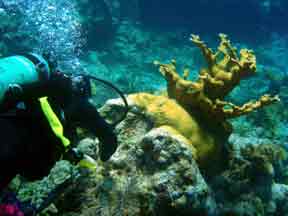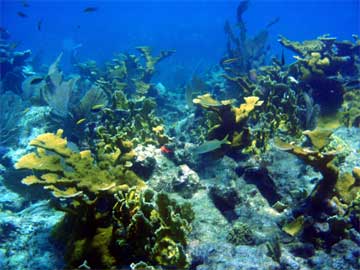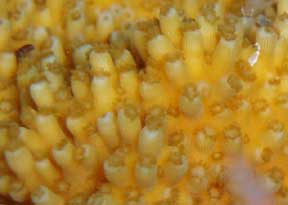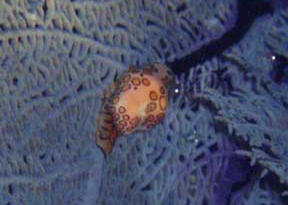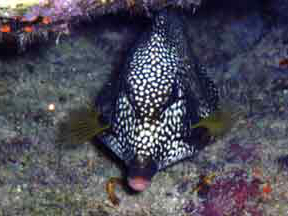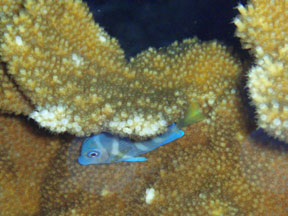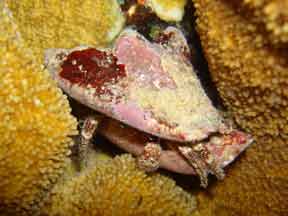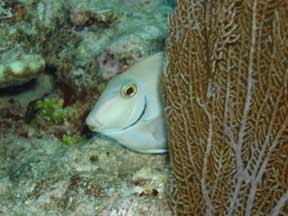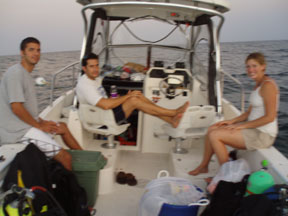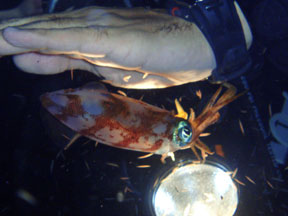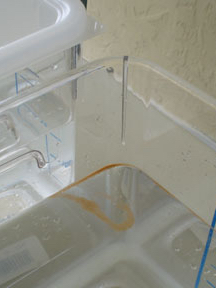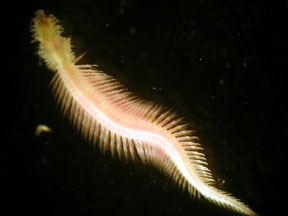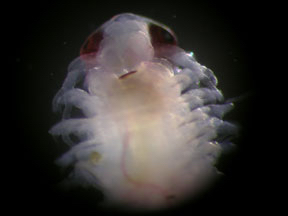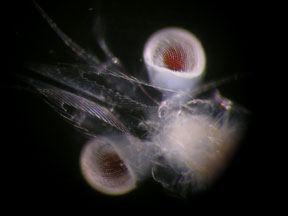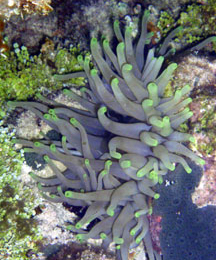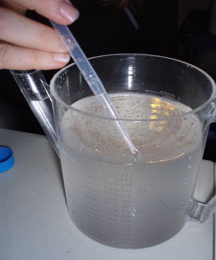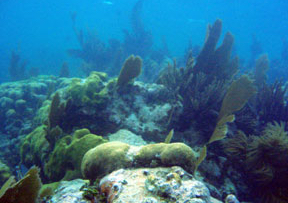Introduction
The full moon of midsummer brings with it the annual spawning of the corals. This year we will be collecting gametes from Acropora palmata (elkhorn coral) in the waters off of Key Largo. A. palmata is a federally listed threatened species which, though once common throughout the Caribbean, has declined by up to 90% through much of its range. Our goal is to enhance efforts to protect and expand populations of this species by promoting a better understanding of their reproduction and helping to establish new colonies for reseeding reefs.
The forecasted night for this year's spawn is the Wednesday the 1st of August. That night we will go diving to collect gamete bundles as they are released from the coral polyps. The bundles, which are composed of both sperm and eggs, are designed to float to the surface where they would naturally be carried by the current. Shortly thereafter they break up releasing the sperm to fertilize other eggs. Once the gametes are collected, we will need to work quickly to separate and prepare the sperm and eggs for further research and get them back to the lab where they can be cared for. With the samples we collect we will perform experiments related to coral larval survival and settlement, and with luck, we will end up with a number of young coral colonies for aquaculture and future study!
Tuesday, 31 July 2007
After arriving in Key Largo on Friday we have been steadily building up for this year's coral spawn. The various downstairs parts of the rental house we are staying in have been converted to a temporary laboratory, an aquarium facility, and a workshop, and the collection gear has all been prepared and packed.
Today we went diving to scope out the reefs we will be collecting from tomorrow night and designate which colonies we will target. Conditions on the water have not been ideal, with a brisk wind kicking up choppy waves, and a stiff current to fight below the surface. Visibility underwater is good, but the intense sun and heathave raised the water temperature to above 86F, and there already appears to be scattered patches of corals showing the initial signs of bleaching.
Tomorrow's forecast is for more of the same, scorching hot and a chance of thunderstorms withwinds up to 10 knots. Our plan is to spend the day finalizing the collection gear, and preparing the lab for the expected influx of samples. Then we will set out in the evening for a dusk dive to orient the collection teams. If all goes as planned we will be bringing back an abundance of gametes and then things will get really busy!
Wednesday, 1 August 2007
We set out on the NOAA boat R/V Oddesey just before six for our first collection dive. Thankfully the wind had died down and the water was relatively calm. By about six thirty we were in the water preparing the plots for the night's dive. After marking the target colonies with glowing bouys, we returned to the boat to wait for sunset.
There was a sense of anticipation as darkness fell and we were surrounded by glowworms spawning in the water all around us. We waited until after nine then got back in the water to see if any of the colonies had begun producing bundles.No bundles were observed tonight, but there was plenty else to see.
It was an amazing night dive (especially for one used to Pennsylvania's murky quarries) with many cool critters that come out at night. We headed back after about an hour and returned to the field house where we met up with the other crew who had similar luck. Maybe tomorrow will be the big night!
Thursday, 2 August 2007
The water was calm as we submerged for our dusk dive this evening. The boat was thrumming directly overhead while we set up the bouys, the reef seemed more active than the night before. Large schools of seargent majors were up feeding by the surface and barracuda and nurse sharks were both nearby.
After setting up and checking on all our colonies we returned to the boat to wait for night to fall. As the stars came out, the glowworms again became active causing the darkness to glitter from above and below!
We returned to our colonies at about nine thirty to check for any signs of gamete formation. The coral polyps were extended, but no gamete bundles were seen on our initial survey, so we practiced setting up the collectionnet and swam around taking pictures of the various fish and spiny lobsters hiding among the branching arms and many crevices of the reef.
By ten thirty and several more scans of the colonies we decided to pack it up for the night. It was just a short swim to the boat from our plot, but as we approached it a huge adult male loggerheadsea turtle emerged from the darkness to pass just below us. It turned and looped around us for a second look before heading off in the opposite direction.
Word from the other team was much the same. Highlights from their evening included a visit from a curious squid (video below), and fun with cylums! Hopefully tommorow night spawning will begin, as it seems the long evenings on the boat are starting to have an effect on people.
Friday, 3 August 2007
This morning there were reports from other sites that a dribble of spawning had begun last night. Research teams in Mexico, Puerto Rico and further south in the Keys observed the release of small numbers of gamete bundles yesterday, and expect more tonight.
The imposing thunderclouds in the distance however, were a bad omen for our expediton, as night four brought dissapointment. No spawn was collected at either site. It is now far enough away from the full moon that some think the corals on our study plots are not going to spawn this month. Our last hope now seems to be tomorrow night, but the weather forcast calls for thunderstorms with winds of 15 - 20 knots and waves 4 - 6 feet high. If this is correct we will not be able to go diving and may be forced to try again next month.
The reef did seem especially alive this evening though. We were greeted by a large school of barracuda when we entered the water, and after dark, the water was swarming with tiny creatures attracted to our lights. There were numerous crabs and anemones observed as well as reef squid and trunkfish.
Saturday, 4 August 2007
This morning we all sat down to discuss our options. The forcast is still shaky, and it seems we will be limited to a single boat. There is a great deal of uncertainty about whether the coral will spawn at all this month. It is now the fith day after the August full moon. Looking over past records it is unusual (but not unheard of) for spawning to occur this late. In 2001 spawn occured on day five, and in 2003 it was seen as late as night nine, but that was a month earlier in July. Unfortunately there is still quite a bit of uncertainty about what triggers coral to spawn. It is known to occur following the full moon, but that is clearly not the only factor. Additional influences may come from the timing of the full moon in the summer months, variation in water temperatures, and of course the health and condition of the corals. This all leads to a rather complicated situation for us and the corals themselves. In order to be able to outcross they must coordinate their spawning somehow, but it seems that different reefs actually spawn at different times. This of course reduces the probabalility that gametes from various reefs will encounter each other at all, a heavy price to pay for a species that puts all its reproductive effort into a single annual event!
Weather permiting, we will try again with at least one crew tonight. Currently it is clear but kind of breezy. So, we will have to see what this evening has in store.
After enjoying some birthday cake in honor of Harold and his nameless friend, a pair of corals that were the products of the coral team's efforts three year's ago, we set out aboard the R/V Palmata for sand island reef at around seven pm . Once there, Abel snorkeled down to mark the target colonies. The wind was not as strong as we thought it was going to be, but the waves were substantial, so we moored near the three sisters area to wait for a couple hours until dark.
When it was finally dark we went down to check for gamete bundles. I thought I saw bundles on a few colonies, but it must have just been wishful thinking since no spawning was observed once again. We will continue to go out the next couple nights to collect Montastrea spawn, but it appears that the palmata will not spawn until next month.
The evening's dive was highlighted by visits from a pair of friendly reef squid, and a well camouflaged reef octopus.
Sunday, 5 August 2007
Tonight the collection team focused their efforts on Montastrea faveolata and returned with several vials of eggs and sperm. Break-up of the bundles was rapid and fertilization occured on the boat before they returned. Back at the house we put the developing embryos into plastic containers with filtered sea water. Samples of the sperm and eggs were separated and preserved for future genetic analyses.
An initial inspection of the eggs under the microscope showed that fertilization had indeed taken place, by the presence of numerous dividing cells. We will assess the fertilization rate when we check on them tomorrow morning.
The collection tubes that were brought back also contained a host of interesting planktonic creatures from down on the reef. These are the same things that have been swarming our lights on all of our dives. They are actually quite beautiful once you slow them down and have a look at them, and they aren't trying to swim in your ear.
Monday, 6 August 2007
The Montastrea larvae collected yesterday are continuing to develop, and tonight we went out to try to get some more. We dove at a site known as Grecian Rocks where there are many large colonies of Montastrea, and a number of Diplora (brain coral) colonies. We set up collection nets over several of them, then waited til about 10:30 to check on them.
The site was physically more complex than where we had been diving previously, and extremely shallow in parts. The reef was surrounded with soft sandy substrate, so a number of different fish species including some interesting gobies were present. The corals themselves were home to quite a few large beautiful anemones, and scallops. And the rocks were inhabited by many worms, shrimp, and a moray eel.
Unfortunately the spawning was less than we had hoped for. Rather than a coordinated mass spawn there was just a trickle of polyps releasing bundles here and there throughout the reef. We did succeed in collecting a small amount of gametes from a few different colonies between 11 and 12 pm however, enough to make some crosses to bring back with us.
The eggs were mostly fertilized on the boat before we returned. Once back on land we washed the them several times to remove the unused sperm and left the young larvae in a container to develop overnight.
Tuesday, 7 August 2007
Well, today is our last day here in the Keys. Because the corals do not seem to want to spawn we will cut our expedition short and work with the Montastrea larvae that we have. So, for now we are packing up a container of larvae and hitting the road for Pennsylvania. It is certainly a dissapointment that we were not able to rear more larvae, but hopefully we will be able to return next month to try again the first week of September.
If I do return I will resume updates, but it seems that is all for now....Thanks for reading along!
Final Update, September 2007
This month Iliana returned to the keys to have another attempt at collecting Acropora spawn. I was unable to join her since classes had resumed at Penn State. Fortunately, she was able to collect a good number of gametes and successfully carry out some crossing experiments. At this point we can say that we have some very exciting results regarding larval survival rates and how they relate to parental genotypes!
During her visit Iliana gained some valuable experience rearing larvae with the help of our friends from SECORE, which puts us in a good position to do some very cool work next summer!
Til then...

